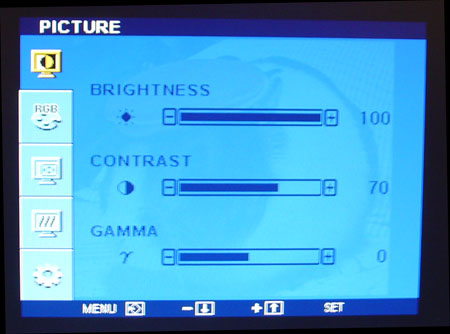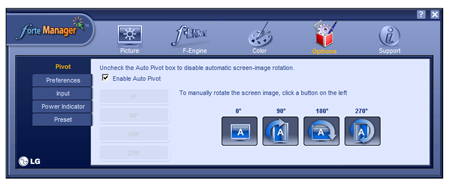LG L1980U LCD: The New 19" Panel on the Block
by Kristopher Kubicki on May 13, 2005 4:00 PM EST- Posted in
- Displays
Panel
Earlier, we alluded to the 12ms Gray to Gray, 16ms GTG LG.Philips LCD panel used in the LGE L1980U. For those interested, you can view a few of the more specific details about the panel on the LG.Philips LCD website. The LM190E04 panel used in this display advertises a 12ms (GTG) response time, 500:1 contrast ratio and 16.2M colors. This is one of the few panels from LG.Philips LCD that does not use their proprietary Super IPS display mode. The Twisted Nematic (TN) display mode is one of the most basic liquid crystal display modes. Panel manufacturers like AUO discovered several years ago that 6-bit TN displays were capable of faster response times due to the fact that fewer degrees of control were needed to control each sub pixel.The 16.2 million colors can be mildly misleading as this is not a true 8-bit (16.7 million color) LCD display. As a 6-bit display, the LM190E04 can only display 6-bits, or 64 degrees, of control when twisting the liquid crystal. Since there are three subpixels, this gives each whole pixel on the panel 262,144 possible hues. LG.Philips LCD attempts to replicate 16.2M colors by interpolating sub pixels that are near each other – this process is called Frame Rate Control or FRC. It works, but comparing an 8-bit LCD to a 6-bit LCD shows the difference in color depth immediately.

When we compared the L190E04 with 19” 6-bit TN displays from AUO, the two displays were indistinguishable.
User Interface
LG definitely hit the nail on the head with regard to the interface on this display.The menu interface buttons and the power on/off buttons are pressure sensitive. The power button is actually nothing more than a perplexing clear acrylic tab hanging from the monitor. While the monitor won’t turn off (or turn on) by just casually bumping into this tab, the right brush of a finger is all the indication that the monitor needs to turn on. Apple isn’t the only one with an interesting control interface anymore.
The other four, multifunction, touch-sensitive interface buttons control the menu interface. Nothing about the menu itself screams innovation, but it is easy to use and allows for a well-balanced level of control.
Samsung has pushed particularly hard over the last few years for a really killer panel management system, but after just a few minutes with LG’s forteManager, we knew that LG had a design win.
F-Engine is really nothing more than a collection of contrast, color and brightness presets; and we have seen this in the past from Dell and Samsung. However, f-Engine wooed us in a particular manner because it split screens the display while you are attempting to choose the optimal preset. The left half of the screen changes to the preset while the right half stays the previous preset. It’s almost like a display writer’s dream come true!
However, the real winner for the L1980U and forteManager is Auto Pivot. Pivoting a display is obviously nothing new, pretty much every display aside from a few entry level models have the ability to rotate the screen into portrait mode. We really haven’t recognized this feature too much in the past because it is awkward – pivoting the display, then enabling the pivot via software just doesn’t sound as friendly as it could be. LG’s Flatron actually recognizes when a pivot occurs and the display notifies PivotPro (via forteManager) to rotate the display. A window pops up via the DSP that notifies the user when the pivot has occurred.
The only drawback to pivoting this display is a semi-moot clearance issue that was also present on the Samsung 193P; there just isn’t enough room to rotate the panel without touching the monitor base. Thus, we need to actually tilt the display first before rotating, and that whole sequence of events can be slightly awkward. Furthermore, the Flatron L1980U does not rotate along the Z axis like most displays, so any sort of change in orientation required us to drag the display across the table.















21 Comments
View All Comments
amuster - Monday, June 6, 2005 - link
I have used the LG1980U for the past two months and agree with the AnandTech review. The darks are washed out. I was also surprised by the narrow viewing angle especially from above the screen. However the display is not unpleasant to use and the exterior design is just wonderful. I was very concerned about blurring having previously used a CRT and I wanted an LCD with good response. This screen is fine. If exterior design must be visually appealing to you and accurate colour rendition is not vital then I highly recommend the LG1980U. I was able to purchase the screen for £350 and at this price have no complaints. It is excellent value.Micronaut - Wednesday, May 18, 2005 - link
We just got a 1905FP and it's HORRIBLE for gaming. The blur is very very bad. I cannot recommend it to anyone that has anything moving on the screen (and yes, I've loaded drivers, played with the vscyn, everything). :(Spacecomber - Tuesday, May 17, 2005 - link
The 910N sounds similar to the 910T, though Samsung lists the 910N's specifications as 250cd and 800:1, while the 910T's specifications are listed as 260cd and 1000:1. Both have 170/170 viewing angles. Perhaps these are the same 25ms PVA panel, but tweaked differently by the monitor's circuitry and backlighting. The main difference is that the 910N looks to be a budget version, in that it is analog only, while the 910T has a DVI connection. Perhaps the lack of the DVI connection has something to do with the lower specifications?(Just to make things more confusing, there also is a 912T, which is specified at 250cd, 700:1, and 170/170. This actually sounds closer to the 910N.)
Looking at Samsung's list of current panels isn't much help in sorting this out. They only list one 25ms PVA panel, the LTM190E1, which they specify as 250cd, 500:1, and 170/170. The only other PVA panel they list is the 8ms LTM190E4, which they specify as 250cd, 1000:1, and 178/178.
In any case, without a DVI connection, I think the 915N is destined to be an inferior monitor to most of the other 19" LCDs that you've reviewed, including the Dell 1905FP.
Space
KristopherKubicki - Monday, May 16, 2005 - link
Space: I have a review of the 910N coming up - which I believe is identical to the 910T.You are also correct on the "overdrive" circuitry - although it is all the same stuff. Each company just feels like calling it something different.
JNo: Those ultra low repsonse times are unfortunately just hype. I can report a 4ms GTG response time, but that probably isnt the average and most likely a single scenario where the crystal is capable of twisting from one shade to another. Marketing seems to have gotten the best of that specification.
nserra: The interpolation is quite noticeable.
Kristopher
WT - Monday, May 16, 2005 - link
Someone offer up a comment on the Acer AL1914smd ... its available for $280 and seems like a great deal. DVI, 500:1 contrast and 12ms response seem like just what I want .. and its under $300. I can't determine whether its a 6 or 8 bit panel and whether that really, truly bothers me as a hard core gamer.LCDs ... about as confusing as wimmin during that 'monthly' thing .. *shrug*
nserra - Monday, May 16, 2005 - link
How bad do these lcds look if one game doesnt run good at 1280x1024? And i have to go for 1024x768 or even 800x600.ElFenix - Monday, May 16, 2005 - link
yet another low resolution 19" LCD. is everyone blind that uses these things?Spacecomber - Sunday, May 15, 2005 - link
These low grey to grey response time monitors, I believe, are all taking advantage of this so-called "overdrive" circuitry. I think that it also goes by the term "feedforward driving", and apparently it was developed by Mitsubishi.This seems like one of those technologies that it would be useful for the reviewers to take a look at and try and separate out the facts from the marketing hype.
It may be that this is nothing that unusual and that it is being used in a wide range of LCDs. Perhaps some manufacturers have made a point about it just to dramatize their low response time numbers.
Space
JNo - Sunday, May 15, 2005 - link
I know anandtech focuses a lot on the Dells and Samsungs in the LCD world (this review notwithstanding), which is in many ways fair enough given their marketshares, but there are other LCDs coming out which I'd like to see reviews of. I know response time isn't everything and is often a controversial subject but I'd love to see priority reviews on the reported 6ms Gray To Gray (GTG) BenQ FP91V+ and the reported 4ms GTG Viewsonic VX924. As #6 puts it, inquiring minds want to know....MrEMan - Sunday, May 15, 2005 - link
Does anyone know which OEM produces Dell's LCD monitors (I recall that some of their CRT monitors were manufactured by LiteON, but I have no idea who makes their LCDs)?I would be interested in how their retail monitors compare to the models they produce for Dell.